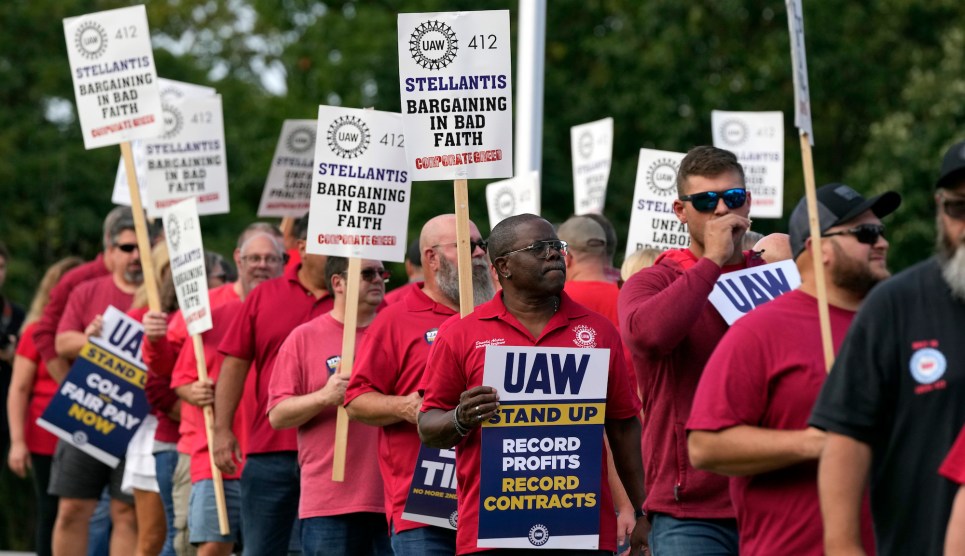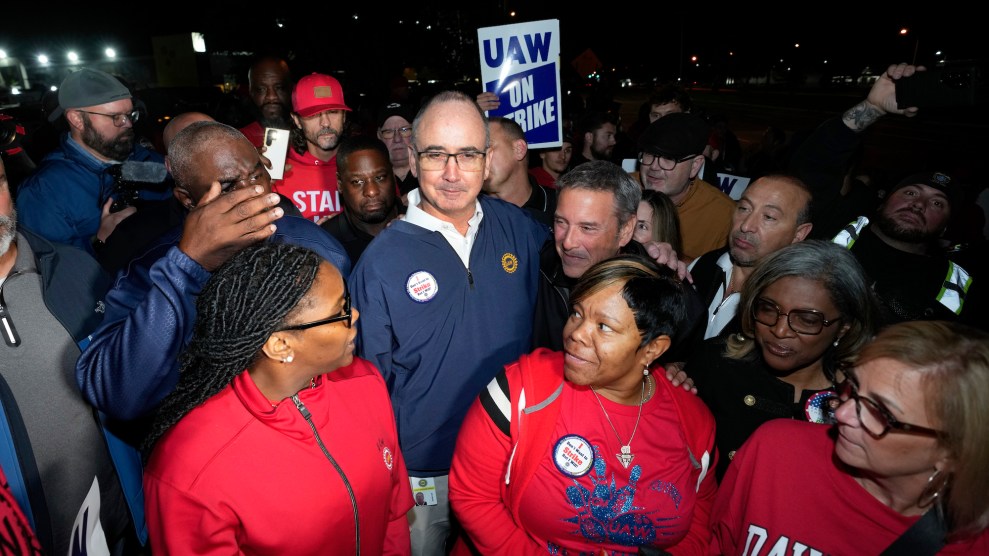
United Auto Workers march outside Stellantis' North American Headquarters on Wednesday.Carlos Osorio/AP
On Friday at noon, the United Auto Workers expanded its strike against the Big Three automakers. UAW President Shawn Fain announced in a Friday morning livestream that his members will be striking at all 38 of the Stellantis and General Motors parts distribution centers that are spread across 20 states from coast to coast.
As Labor Notes has reported, parts distribution centers are major profit centers for the Big Three. They hold spare parts and accessories that are often sold at significant markups. Before the strike, Ford was reportedly training 1,200 salaried employees to keep its distribution centers open.
Unlike the first round of the UAW strike last week, which went after all Big Three automakers, these strikes will only target General Motors and Stellantis. “We will shut down parts distribution until those two companies come to their senses and come to the table with a serious offer,” Fain explained.
The roughly 13,000 members who went on strike last week at three plants owned by Ford, General Motors, and Stellantis will remain on the picket lines. They will be joined by roughly 5,500 workers from GM and Stellantis parts distribution centers.
Ford is being spared because it has made significant concessions. One of the union’s biggest demands has been to eliminate wage tiers that divide workers and undermine the idea of equal pay for equal work. Fain said Ford has agreed to bring the nearly 3,000 workers at its Rawsonville Components Plant and Sterling Axle Plant onto the same wage scale as other assembly plants. In another major breakthrough, Ford has said it would reinstate the cost-of-living adjustments that its workers gave up in 2009, during the Great Recession, to help keep the company afloat. Fain noted that GM and Stellantis continue to insist on a substandard COLA formula that is projected to provide no benefits to workers over the life of a four-year contract.
“To be clear, we’re not done at Ford,” Fain added. “We still have serious issues to work through, but we do want to recognize that Ford is showing that they are serious about reaching a deal.”
Polling from Morning Consult shows support for the strike has increased since it began. Fifty-four percent of American adults reported backing the strike with only 18 percent opposed, compared to 51 percent and 23 percent, respectively, before it began.
During the livestream, Fain invited everyone “all the way up to the president of the United States” to join workers on the picket line. The open invitation comes before former president Donald Trump is expected to head to Detroit next week to speak to union workers. He will likely sell himself as a champion of working people, despite the deep hostility to organized labor during his administration. Fain has previously said about Trump’s visit that “every fiber of our union is being poured into fighting the billionaire class and an economy that enriches people like Donald Trump at the expense of workers.”
Stellantis is expected to be the hardest company for the UAW to come to an agreement with. Mark Stewart, the company’s COO for North America, was mocked by union supporters last month for joining contract negotiations by videoconference from his second home in Acapulco, Mexico.
Exor, the holding company of Italy’s Agnelli family of industrialists, is Stellantis’ largest shareholder. John Elkann, the family’s billionaire scion, serves as chairman of Stellantis, which owns 14 car brands including Chrysler, Fiat, Jeep, and Maserati. Through Exor, the Agnellis own Juventus, one of Italy’s most famous soccer teams, and are the largest shareholders of The Economist Group and Ferrari. They also have a major stake in Christian Louboutin.
Ford has a similar family dynamic. The organization’s founding family retains control of the company: Bill Ford, a great-grandson of Henry Ford, serves as executive chair. The company has traditionally had a better relationship with union workers. This is the first time the UAW has struck against Ford in the United States since 1976. General Motors lacks the other two company’s deep ties to one family; Automotive Dive reports that it is ultimately expected to follow Ford’s lead.
In addition to other breakthroughs, Ford has told the UAW it will allow workers to strike over plant closures. It would additionally provide health care and “income security” for up to two years in the event of indefinite layoffs. The other Big Three automakers have rejected all of the UAW’s job security proposals, Fain said.
Profit-sharing payments would increase by 13 percent at Ford and temporary workers would be eligible to receive them after 90 days on the job. GM and Stellantis have rejected enhanced profit-sharing, despite the Big Three having made roughly $250 billion over the past decade.
Fain stressed that his members are willing to hold out until they get an acceptable offer. “We will be everywhere from California to Massachusetts—from Oregon to Florida. And we will keep going, keep organizing, and keep expanding the stand up strike as necessary,” he explained. “Across the country, people are going to know that the UAW is ready to stand up for our communities and ready to stand up against corporate greed.”
















